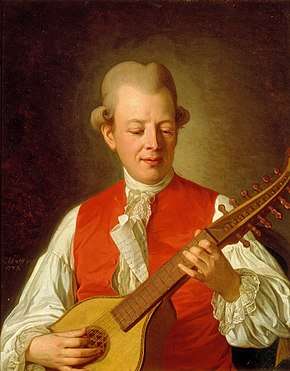Gubben Noak
"Gubben Noak" (originally "Om gubben Noach och hans fru" or just "Gubben Noach", and since 1791 also "Fredmans sång n:o 35")[1] is a traditional Swedish song, a drinking song and bible travesty written in 1766 (or possibly earlier), with text by Carl Michael Bellman.[2] The song is possibly the best known of all Bellman's works.

Context
Carl Michael Bellman is the central figure in Swedish song, known for his 1790 Fredman's Epistles and his 1791 Fredman's Songs. He played the cittern, accompanying himself as he performed his songs at the royal court.[3]
Jean Fredman is a fictional character and the supposed narrator in Bellman's epistles and songs, based on a real watchmaker of Bellman's Stockholm.[4] The epistles paint a picture of the demimonde life of the city during the eighteenth century, where strong drink and beautiful "nymphs" like Ulla Winblad create a rococo picture of life, blending classical allusion and pastoral description with harsh reality.[3][4]
Song

The song is in 2
4 time. The setting for the song is the time when Noah from the Old Testament had come to rest on the mountains of Ararat, and as mentioned in the Book of Genesis 9:20–21, Noah established a vineyard and got drunk from drinking the wine. The rest of the story departs from the biblical account. Along with Fredman's Songs 36–43, such "Joakim uti Babylon" and "Ahasverus var så mäktig", Gubben Noak is one of the biblical travesties that made Bellman popular during the 1760s.
Distribution
Being somewhat afraid of the church, Bellman chose to first publish the song anonymously on broadsheets throughout the country; although it was generally known at the time who had composed the song.
In 1768 the Lund chapter reacted by sending a letter to the priests of the diocese, attempting to collect all prints and transcripts of "Gubben Noach" and other biblical travesties, in order to have them destroyed.[2][5][6]
In 1791 "Gubben Noak" was included in the song book Fredmans sånger, along with eight other biblical travesties, such as "Gubben Loth och hans gamla Fru" (Songs of Fredman no 35–43).
Simplified and more innocent versions of the song have become popular as children's songs.
English versions of "Gubben Noak" have been recorded by Adam McNaughtan [7] and the Linköping University Male Voice Choir.[8]
Melody
Earlier sources for the song's melody have not been found.[2] The same melody has been used for other songs, including the popular Swedish children's song Björnen sover.
References
- Bellman, Carl Michael (1766 or earlier). "N:o 35 Gubben Noak" (in Swedish). Retrieved 2008-10-17. Check date values in:
|year=(help) - "N:o 35" (in Swedish). Retrieved 2008-10-17.
- "The Life and Works of Carl Michael Bellman. A Short Biography". The Bellman Society. Archived from the original on 18 January 2015. Retrieved 15 January 2015.
- Britten Austin, 1967. Pages 61–93.
- Domkapitlet i Lund (1768). "Som til Consistorium blifwit inlemnade ..." (in Swedish). Retrieved 2008-10-17.
- "Bellman. Verken" (in Swedish). Retrieved 2008-10-17.
- Last Stand At Mount Florida (Cockenzie: Greentrax Recordings, 1996).
- In English (Linköping: Linköpings studentsångare, 2013).
Sources
- Britten Austin, Paul. The Life and Songs of Carl Michael Bellman: Genius of the Swedish Rococo. Allhem, Malmö American-Scandinavian Foundation, New York, 1967. ISBN 978-3-932759-00-0
- Britten Austin, Paul. Fredman's Epistles and Songs. Stockholm: Proprius, 1990 and 1999.
- Hassler, Göran; Peter Dahl (illus.) (1989). Bellman – en antologi [Bellman – an anthology]. En bok för alla. ISBN 91-7448-742-6.CS1 maint: multiple names: authors list (link)
- Kleveland, Åse; Svenolov Ehrén (illus.) (1984). Fredmans epistlar & sånger [The songs and epistles of Fredman]. Stockholm: Informationsförlaget. ISBN 91-7736-059-1.CS1 maint: multiple names: authors list (link) (with facsimiles of sheet music from first editions in 1790, 1791)
External links
- Old boy Noah by John Irons
